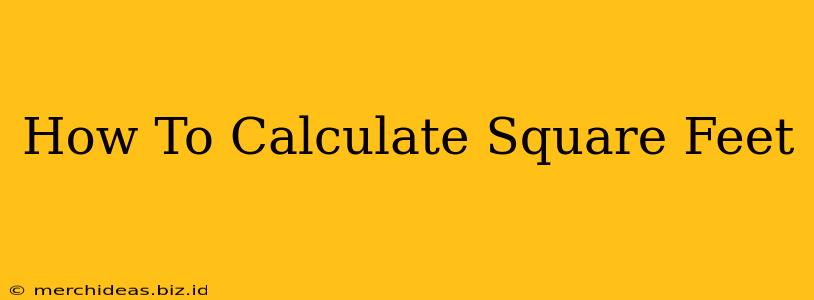Knowing how to calculate square feet is a valuable skill, whether you're planning a home improvement project, buying flooring, or determining the size of a property. This comprehensive guide breaks down the process, offering different methods for various shapes and scenarios. Let's dive in!
Understanding Square Footage
Square footage refers to the total area of a space measured in square feet. One square foot is a square with sides measuring one foot each. Calculating square footage is crucial for accurate estimations in various fields, including:
- Real Estate: Determining property size and value.
- Construction & Renovation: Estimating material needs and project costs.
- Interior Design: Planning furniture placement and room layouts.
- Landscaping: Calculating the amount of sod, mulch, or other materials needed.
Calculating Square Feet for Rectangular Spaces
This is the most common calculation and the easiest to understand. For rectangular spaces (including squares, as a square is a special type of rectangle), you simply multiply the length by the width.
Formula: Square Footage = Length (ft) x Width (ft)
Example: A room measuring 12 feet long and 10 feet wide has a square footage of 12 ft x 10 ft = 120 square feet.
Step-by-Step Guide for Rectangular Spaces:
- Measure the length: Use a measuring tape to accurately determine the length of the space in feet.
- Measure the width: Similarly, measure the width of the space in feet.
- Multiply: Multiply the length by the width. The result is the square footage.
Calculating Square Feet for Irregular Shapes
Calculating square footage for spaces that aren't rectangular requires a slightly different approach. Here are some common methods:
1. Dividing Irregular Shapes into Rectangles:
If the irregular space can be divided into several smaller rectangular areas, calculate the square footage of each rectangle individually and then add the results together.
Example: A L-shaped room can be divided into two rectangles. Calculate the square footage of each rectangle and sum them for the total square footage of the L-shaped room.
2. Using the Area of a Triangle:
For triangular spaces, use the following formula:
Formula: Area = (1/2) x base x height
Where:
- Base: The length of the triangle's base.
- Height: The perpendicular distance from the base to the opposite vertex (the highest point).
3. Approximation for Complex Shapes:
For very complex shapes, you might need to use more advanced geometric formulas or consider using grid-based approximation techniques. This often involves overlaying a grid onto the space and estimating the number of squares within the shape.
Important Considerations:
- Accurate Measurements: Precise measurements are essential for accurate calculations. Use a measuring tape and take multiple measurements to ensure accuracy.
- Units: Ensure all measurements are in feet. If measurements are in inches, convert them to feet before calculating. (12 inches = 1 foot)
- Obstacles: When calculating the square footage of a room, account for any permanent fixtures that reduce usable space, such as built-in wardrobes or pillars. You may need to subtract their area from the total.
Tools and Resources:
While manual calculation is straightforward, several online calculators and apps can assist with square footage calculations, especially for complex shapes. These tools can save time and reduce the risk of errors.
Conclusion:
Calculating square footage is a fundamental skill with numerous practical applications. Mastering the techniques outlined in this guide will equip you to handle various scenarios confidently, whether you're planning a home improvement project or simply need to determine the size of a room. Remember to always double-check your measurements for accuracy!
